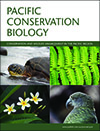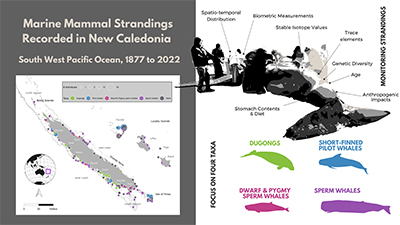Pacific Conservation Biology
Volume 30
Number 1 2024
Rarely-encountered species of odontocetes often get little research attention or funding to study them. We describe an approach to maximise information from these species while undertaking studies of more common ones, and illustrate this approach with information on pygmy killer whales, a poorly-known and rarely-encountered delphinid in Hawai‘i.
This article belongs to the Collection Marine Mammals in the Pacific.
Separation between humans and nature leads to an eco-deficit culture. We argue that the kingfisher can bridge the connection between humans and nature. In science, the kingfisher is an indicator species to evaluate alterations in wetlands. In indigenous knowledge systems, it is a predictor of environmental variability and is a valued resource for developing community science. Thus, as a symbol, the kingfisher can restore the lost bond between humans and the natural environment, and transform human value systems from eco-deficit to eco-surplus mindsets.
This study simultaneously describes the spatial distribution and densities of 22 distinct taxonomic groups of marine mammals, sea turtles, elasmobranchs and seabirds over three large oceanic subregions of the western and central South Pacific Ocean. It demonstrates the value of multi-taxa monitoring applied to aerial surveys of offshore marine megafauna, and provides a baseline for future conservation measures.
This article belongs to the Collection Marine Mammals in the Pacific.
Jenny Davis was among the first small, but significant tranche of female field biologists in the Pacific Region. Jenny is one of the few women to be promoted to the academic rank of Professor in Australian sciences. Her current research involves answering two questions: (1) how much water does the environment need; and (2) how important are isolated aquatic waterbodies for the conservation of Australia’s freshwater biota? This paper is a brief biography of Jenny.
Conservation of marine mammals in Oceania is limited by a lack of understanding of these relatively rare, yet emblematic species. Here, we report on significant biological and ecological data acquired from several decades of monitoring strandings in New Caledonia. This increased knowledge may help guide management measures locally and regionally. Photograph by Marine Mammal Stranding Center.
This article belongs to the Collection Marine Mammals in the Pacific.
The first investigation into the diversity and distribution of cetaceans in the Republic of Palau was conducted. It resulted in a cetacean species inventory confirming the presence of 15 species and identifying seven as either probable or likely present. The study contributes to the management of cetaceans in Palau National Marine Sanctuary and Protected Area Network.
This article belongs to the Collection Marine Mammals in the Pacific.
Here, we analysed the data from two terrestrial fauna surveys undertaken in different fauna habitats that are common in Western Australia. Although environmental practitioners comply with the Western Australian Environmental Protection Authority’s (EPA’s) terrestrial fauna survey guidelines when surveying one site in each fauna habitat type, these surveys typically collect insufficient data to record more than 60% of the terrestrial species present. They are also unlikely to provide better quality data on species richness than publicly available from a desktop assessment. In addition, it is difficult to provide a scientific justification to an animal ethics committee for undertaking low intensity surveys when desktop surveys may provide adequate information for an environmental impact assessment. Therefore, these surveys probably should not be approved. We argue that the EPA should rewrite its existing guidelines.
Seed banks are an important tool for plant conservation. However not all species can be stored. We compiled information on seed storage for New Zealand plants, finding that 83% could be stored in a seed bank. Plants unable to be banked are generally bird-dispersed canopy trees, including some threatened species.
We present an analysis of the movement metrics of an endangered species through satellite telemetry, to investigate if variation in movement and foraging behaviour occurs at the regional level and what this means for habitat conservation plans.
Introduced rodents are highly destructive island invaders the world over. Control programs are usually ground-based, however our study found that black rats (Rattus rattus) dominated the forest mid-storey and canopy, casting doubt on the effectiveness of solely ground-based programs. Including above-ground control in the conservationist’s rodent control arsenal may improve outcomes for island biodiversity.
Field observations of 27 neonate bull sharks with red eyes in the Rewa River, Fiji, raised concerns about water quality. Analysis indicated high levels of Escherichia coli contamination, ammonia, and total nitrogen. However, the definitive causal relationship is yet to be investigated.
Synthesis of contemporary research into the effects of fire on dry eucalypt forest birds is imperative, given that wildfire activity is increasing across south-eastern Australia. Recent studies have gained insights into the complexity of avian fire responses. We identify and discuss high-priority knowledge gaps and management issues in this domain.
We provide evidence that the Mountain Ash (Eucalyptus regnans) community in the Central Highlands of Victoria, Australia, is extensively degraded, heavily fragmented, suffering widespread biodiversity loss, and at high risk of ecological collapse. Hence, we recommend they should be listed as a Threatened Ecological Community under the Australian Government Environment Protection and Biodiversity Conservation Act Act.
With increasing pressures on Australian forests, identifying old growth and mature habitats for threatened species is vital. We evaluated greater glider habitats and found that mature areas are vulnerable to human impacts. Protecting areas containing mature forests and hollow-bearing trees is crucial for the species’ survival.
The K’gari (Fraser Island) World Heritage Area in Queensland faces threats from visitor impact, fire practices, invasive species, and climate change. A two-decade study examined vegetation changes at 22 monitoring sites. Although fire events occurred, there were no significant differences in species richness or composition over time. Recently burned sites showed higher dissimilarity. Six invasive plant species were identified. Timely implementation of existing planned burn guidelines is crucial for mitigating risks and preserving the K’gari vegetation communities.
Indigenous peoples’ biocultural visions are poorly represented in mainstream conservation. Māori, of Aotearoa, New Zealand, desire equity in managing their natural resources, and have developed biocultural monitoring approaches. Decolonising conservation systems reinvigorates and supports Indigenous peoples self-determination, and is a step in reversing global biodiversity.
The Golden Trevally, Gnathanodon speciosus, is a large predatory fish with an extremely broad tropical Indo-Pacific distribution crossing many biogeographical boundaries. Published information and freely available imagery suggest that small juvenile G. speciosus are often associated with whale sharks, Rhincodon typus; an association that could explain their unusually wide-spread distribution, and suggests a novel nursery relationship. The occurrence of such an association reshapes our understanding of the ecological roles played by long-range migrants such as R. typus and other megafauna.
The freshwater leech Helobdella europaea is a globally invasive species which preys on freshwater invertebrates and is now confirmed present in Fiji. We provide and describe a new genetic resource (complete mitochondrial genome sequence) for tracking its spread to other regions. These findings will inform appropriate biosecurity assessments and responses.
The health of Australia’s fish and fisheries are of critical ecological, economic, cultural and social importance. The horizon scan approach identified key questions across seven themes related to fish and fisheries within Australia which allow researchers to target their skills and further investment towards addressing.
Biological invasions are a major cause of biodiversity loss. However, the behavioural interactions occurring between native and invasive species are often unknown. We report aggression in the wild between the invasive plague skink and a native New Zealand skink. Our study demonstrates that plague skinks may pose a threat to native skinks.
In the urbanised areas of the south-west Western Australian biodiversity hotspot, both native bees and honey bees visit more native than exotic flora, however native bees visit a higher proportion of native flora than honey bees. Conserving bees in urban greenspaces requires high proportions of preferred native flora.
Climate change is a threat to food systems and assessing fisheries’ strengths and vulnerabilities remains a challenge. To examine climate resilience in the Kiribati giant clam fishery, we adopt a participatory framework, interpreted in the light of the precautionary principle, to highlight attributes conferring resilience. We demonstrate resilience attributes in practice to identify precautionary measures of climate resilience.
Carnaby’s Black–Cockatoos have experienced significant range contraction and population decline. We studied an isolated population breeding at the edge of the species range, hundreds of kilometres north of the next-nearest known breeding location. We recommend direct management actions to support continued breeding at the site.
Seeds of Coprosma kauensis, an IUCN Red List Vulnerable endemic Hawaiian species, germinate over a range of temperatures, but germination rate (speed) is increased by gibberellic acid (GA3). Fresh seeds are desiccation tolerant and can survive short-term storage at −18°C. However, future studies are needed to determine the optimal temperature for long-term storage.
Tasmania is globally renowned for its biodiversity, but many of its plant species are at risk of extinction. Using rapid IUCN Red List assessments, we identify 570 threatened plant species, equivalent to 30% of the island’s flora. Less than half of these species are currently listed as threatened under legislation. We find that threatened plants are concentrated near urban areas, and outside of protected areas.
Papua New Guinea has been identified as a sawfish ‘stronghold’ nation, however, sawfish are threatened by gillnet fishers who often amputate the rostrum to assist in dis-entanglement. Here, we describe an account of a recapture of an emaciated amputee sawfish. We also present a sawfish safe release guide, developed for the small-scale fishery context of Papua New Guinea.
Dams are known to impact fish community structure, however, the impacts of dams on the fish community in Indonesia is understudied. We sampled the fish community upstream and downstream of a dam fitted with a fishway, identifying significant differences in fish community structure. This highlights the need for further research into the operation of the dam, and fishway, to improve fish passage success.
Pervasive components of marine shoreline development – such as residential docks – are a growing concern for sustaining nearshore ecosystems. We review the impacts of small docks, finding robust evidence for impacts on seagrasses but sparse or inconsistent evidence for impacts on kelps and fishes. We highlight substantial data gaps that preclude informed policies, permitting, and restoration actions.
Penny Olsen was among the first small, but significant tranche of women field biologists. Penny is a world-renowned ornithologist and author who has spent her entire career passionately pursuing conservation of Australian wildlife and making science decipherable to ordinary readers. This paper is a brief biography of Penny.
Julie Savidge was among the first small, but significant tranche of women field biologists. Her PhD research on the Pacific Island of Guam, stands as a textbook example of ecological problem solving and the first example of the devastating impact of an introduced reptile on an island fauna, the consequences of which continue today. This paper is a brief biography of Julie’s life.






